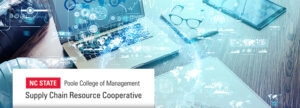Dealing with Supply Chain Uncertainty After Covid: Insights from the Experts
A small group of executives enjoyed a particularly interesting set of insights yesterday at our first Supply Chain Resource Cooperative meeting since December, 2019. Meeting on a rainy day at the NC State Faculty Club, we enjoyed some great opinions and discussions from three very different perspectives. But as one person who attended noted, “After hearing from all three, I could see how what they were all saying started to fit together and make a lot of sense!” That is the sign of a great set of discussions from experts in my opinion!
I helped to set the stage by providing an overview of the disruptions occuring in manufacturing, ports, transportation, carriers, and the resulting increases in material, labor, and transportation costs. This was without doubt a sobering presentation, and no one who sat in felt very good about the remainder of 2022 and the likelihood of inflation and continued shortages of semiconductors, materials, and labor. However, as someone also said afterwards, “Well at least you were realistic and honest!”
Next, Bill Sullivan, Executive Vice President from the American Trucking Association, shared with us his views from the Hill, providing an overview of some upcoming legislation that will impact transportation and shipping problems across the country. He shared with us the fact that the chip shortage is resulting in reduced deliveries from truck manufacturers, who are unable to keep up with demand for new trucks. Also, the on-going shortage of drivers is driving up wage rates – leaving a 60,000 driver shortfall which has recently increased to 90,000, and could continue to 160,000. He also noted that the port issues will continue to be a problem, and that the LA/Long Beach port in particular is beset with problems that are so complex and multi-layered that it will be impossible to fix in the short term. Unfortunately, this will make things very difficult for the Biden administration, who will be absorbing a lot of the blame for inflation and shortages, even though they have little impact on this issue. The good news is that driver wages are going up and that in some cases drivers are making more than $100K for big box retailers. He also mentioned the new legislation that will likely be passed, that will enable 18 year olds to get their Commercial Drivers License, and will create a new younger generation of responsible drivers. The other issue is the Drive Safe Act, which will seek to ensure these young drivers will be properly trained and certified. The other issue for trucking is parking – there is an incredible shortage of it for trucks, and provision of safe and secure parking would also encourage more females to become truck drivers in the future. However, he also pointed out that automation is not likely anytime soon – as I’ve pointed out in previous blogs, the technology is simply not safe yet.
Our second speaker was Rob Johnson, PhD. I’ve known Rob for many years, and he has deep experience working on the culture of intelligence, as well as incredible insights on how to use analytics, machine learning, and AI in combing mountains of data for analytic insight. Rob provided some compelling views on how to re-conceptualize supply chains given the current set of challenges we face in the world today. He discussed this in the context of my new book, FLOW, asking the question: “Are we really measuring the right things in supply chains today? What is the alternative to just being focused on cost? What are the implications of not just focusing on cost anymore in global supply chains? What if instead we focused on FLOW?”
He also provided some fascinating views on the Russia-Ukraine war. Rob started out by pointing out that “To Putin, nothing is bigger than Putin. Politicians behave in wierd ways when confronted with data, and they will pitch local solutions to whatever they are selling!” Because of this, no one can really predict what he will do next, but that it would be possible to invest time in exercises and modeling for future state situations that could lead to some unexpected and interesting conclusions. In general, the Russian equipment is not well maintained, the KGB is not great at carrying out their plans (a lot of messed up poisonings), and there is likely no way that Putin and Russia will get out of this situation with any level of success. The recent spate of oligarch killings are also a sign that he is becoming desperate, and it is certain that the outcome although drawn out, will not leave Russia unscatched. It is unlikely, for instance, that their oil and gas supply chain will ever return to its former self, and that Europe will ever rely on them for these resources again.
Finally, General Jim Trogdon, the former Secretary of Transportation in North Carolina, provided some interesting insights into transportations. He pointed out that the new Infrastructure Bill is indeed dedicated to real structural improvements, is the largest in our country’s history, which will lead to massive projects on our roads, bridges, ports, and rail lines. This will only accelerate our logistics network improvement, accelerate e-commerce and e-fulfillment, and that the electric vehicle manufacturing growth will continue. However, this could lead to reduced bus transit, reduced rail freight, and fewer fixed routes. He is also big on the growth of autonomous national vehicle fleets, although this will likely be light duty in nature.
Together, these insights provided a fascinating background for our student gallery walk. I had the opportunity to meet with some incredible students that worked on projects all related to critical insights facing companies today, from global material cost indices, facility sustainability metrics, and predictive cost modeling. Thanks to all of our project sponsors for their extraordinary efforts and providing this learning experience to our students!


